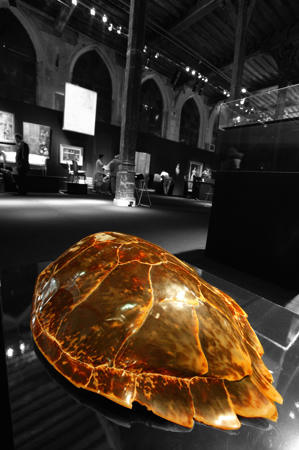Turtle-shell
Today's fashion magazines treat turtle-shell as if it was just another shade of plastic. Yet genuine turtle-shell remains highly prized by those that really understand it.
 Turtle-shell is an ancestral material that has always stimulated man's imagination. In Classical times Virgil, Ovid and Juvenal described furniture encrusted with turtle-shell. In his satire, "The Dialogue of the Gods", Lucien de Samosate shows Apollo telling Vulcan how Mercury invented a turtle-shell lyre.
Turtle-shell is an ancestral material that has always stimulated man's imagination. In Classical times Virgil, Ovid and Juvenal described furniture encrusted with turtle-shell. In his satire, "The Dialogue of the Gods", Lucien de Samosate shows Apollo telling Vulcan how Mercury invented a turtle-shell lyre.
Many of the peoples in Western Polynesia used it to decorate themselves or objects that symbolised power. Asia was also a big consumer of boxes and canes decorated with turtle-shell from China. Many were preserved in the Shoso-in treasure from the 8th century, in the Nara period. Canton later became the main centre of production.
In Japan, the first turtle-shell workshop dates as far back as 16th century Nagasaki.
From the remarkable cradle of Henry IV, made from one complete shell, to the finest inlaid furniture of the 18th century and onwards to the combs, glasses and cigarette holders of the 19th and 20th centuries, it could be found everywhere in Europe and Asia. Inlaid, joined or moulded for the pleasure of connoisseurs.
Turtle-shell is a living, noble material that is both natural and sophisticated. It is rich in infinite reflections that range from dark brown to blonde, sometimes taking on honey tones that give it the transparency of glass.
The great Portuguese navigators were the first to introduce turtle-shell into Europe from the l6th century onwards. Ferdinand Cortez was one of the first to refer to it. The raw material that was being imported had to be reinvented and mastered by the craftsman of the day.
This took 30 to 50 years of research and practice to arrive at the perfect mastery of the 17th century, the period during which turtle-shell became highly sought after.
Meanwhile, fashion in furniture was changing. Around 1625, heavy dressers in solid oak began to be replaced by flamboyant lacquered cabinets that merchants brought back from the East Indies. Ebony and turtle-shell decoration was an exotic product highly sought-after by the nobility. The complex work of these new materials demanded totally new know-how.
In France, it would appear that Marie de Médicis was at the root of the taste for ebony furniture. The specialists in this craft took the name of ebénistes (cabinet makers) and were mentioned the first time in Paris in 1638.
Germany and England welcomed turtle-shell with the same enthusiasm. The France of Louis XIV saw the golden age of turtle-shell in particular thanks to the cabinetmaker Charles-André Boulle (1642-1732). He developed and perfected en France the veneering of marquetery already used by the Florentines since the start of the 16th century.
This technique resulted in some of the finest masterpieces of the art of furnishing that included consoles, desks and tables, hanging wall clocks, coffers and cabinets.
The discovery in the 19th century of the possibility of autografting enabled a higher volume of work, and considerably extended the applications. Turtle-shell could now be welded, turned, sculpted, shaped and this enabled craftsmen to create work of lace-like dexterity.
The fashion for long hair was particularly suited to this new application of turtle-shell, leading to the creation of all sorts of accessories such as combs, hairpins and brushes that were very often produced in turtle-shell up until the 1960s.
Before the war, rich Spaniards came to Paris to buy enormous combs (up to 60 cm) for their mantillas, sculpted and pierced like the finest jewellery. These objects were sold in shops called "Articles de Paris", at milliners and in some specialised boutiques.
The extreme lightness of turtle-shell makes it a favourite material for opticians. Glass frames in turtle-shell weigh no more than 16 g, do not slide and are totally analergic. Its anti-static properties enable the creation of combs that are still sought after by hairdressers.
The finest travel trunks, commissioned by prestigious clients, were produced either in ivory or turtle-shell and customised with the client's initials incrusted in gold in the turtle-shell. These exceptional orders, which required months of work, stopped at the outbreak of the 2nd World War.
Turtle-shell craftsmen such as those at the Maison Bonnet, of which there were nearly 200 at the start of the 20th century, can now be counted on the fingers of one hand.